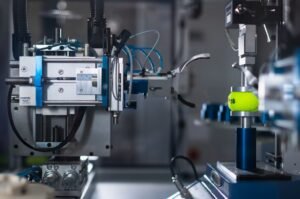Neural Network Recommender System
In the rapidly evolving world of technology and data analysis, neural network-based recommender systems have emerged as powerful tools for personalized recommendations. Leveraging the capabilities of artificial neural networks, these systems analyze vast amounts of data to provide users with tailored suggestions.
Key Takeaways
- Neural network recommender systems utilize artificial neural networks to make personalized recommendations.
- They analyze large amounts of data to understand user preferences and behaviors.
- These systems find similarities between users and items to generate accurate recommendations.
- The training process involves optimizing the neural network model to minimize prediction errors.
Artificial neural networks are designed to simulate the behavior of the human brain’s interconnected neurons, making them ideal for handling complex tasks such as recommendation systems. The neural network models used in recommender systems can be trained using various algorithms, including deep learning techniques like Convolutional Neural Networks (CNNs) and Recurrent Neural Networks (RNNs).
Neural network recommender systems utilize artificial neural networks to understand user preferences and provide accurate recommendations.
How Neural Network Recommender Systems Work
Neural network recommender systems work by following a series of steps:
- Collecting and preprocessing data: The system gathers user and item data, such as user ratings and item features.
- Training the neural network: Using the collected data, the neural network model is trained to learn patterns and relationships between users and items.
- Generating recommendations: Based on the learned patterns, the system predicts user preferences and generates personalized recommendations.
During training, a neural network model tries to minimize the error in predicting user ratings or preferences. This is achieved by adjusting the weights and biases of the network through an optimization process. The model learns to make accurate recommendations by finding similarities between users and items in the input data.
By adjusting the weights and biases, the neural network model learns to make accurate recommendations.
Benefits of Neural Network Recommender Systems
Neural network recommender systems offer several advantages over traditional recommendation approaches:
- Personalization: These systems tailor recommendations to individual users based on their preferences, increasing user satisfaction.
- Improved accuracy: Neural networks can uncover complex patterns in data, leading to more accurate recommendations compared to other methods.
- Scalability: With their ability to handle large datasets, neural network recommender systems can scale to support growing user bases and item catalogs.
Table 1 illustrates a comparison between traditional collaborative filtering techniques and neural network-based recommender systems:
| Collaborative Filtering | Neural Network Recommender Systems | |
|---|---|---|
| Approach | Based on user-item interactions | Utilizes artificial neural networks |
| Personalization | Offers limited personalization | Provides highly personalized recommendations |
| Scalability | May face scalability issues with large datasets | Efficiently scales to handle large datasets |
Challenges in Implementing Neural Network Recommender Systems
While neural network recommender systems offer great advantages, they also come with their own set of challenges:
- Complexity: Developing and training neural network models can be complex and require specialized knowledge.
- Data requirements: These systems heavily rely on large and diverse datasets to make accurate recommendations.
- Computational resources: Training and deploying neural network models often require significant computational power and storage.
Implementing neural network recommender systems can be challenging due to the complexity of developing models and data requirements.
Future Directions in Neural Network Recommender Systems
As technology continues to advance, neural network recommender systems are expected to evolve and improve. Some potential future directions include:
- Hybrid approaches: Combining different recommendation techniques to leverage the strengths of each approach.
- Explainability: Developing models that can provide explanations for their recommendations to enhance user trust and understanding.
- Real-time adaptation: Building systems that can adapt and adjust recommendations in real-time based on evolving user preferences.
| Feature | Description |
|---|---|
| Hybrid Approaches | Combining different recommendation techniques for more accurate and diverse recommendations. |
| Explainability | Providing explanations for recommendations to enhance user trust and understanding. |
| Real-time Adaptation | Dynamic adjustment of recommendations based on real-time user preferences. |
Embracing the Power of Neural Network Recommender Systems
Neural network recommender systems have revolutionized the way personalized recommendations are generated. With their ability to understand user preferences and provide accurate suggestions, these systems have great potential for enhancing user experiences in various domains.
As technology continues to progress, we can expect neural network recommender systems to become even more advanced, incorporating hybrid approaches and real-time adaptation. Embracing these advancements will enable businesses to deliver tailored experiences and gain a competitive edge in the ever-growing digital landscape.
Embracing the power of neural network recommender systems has the potential to revolutionize personalized recommendations and enhance user experiences.

Common Misconceptions
Misconception 1: Neural Networks Only Recommend Popular Items
One common misconception about neural network recommender systems is that they only recommend popular items. While it is true that these systems are often trained on large datasets that include popular items, they also consider the preferences and similarities of individual users. Neural networks are capable of learning complex patterns and taking into account a user’s unique preferences, which allows them to recommend items that may not be widely popular but are highly relevant to a specific user.
- Neural networks consider individual user preferences
- They can recommend niche items that are relevant to a specific user
- Popular items may still be recommended, but they are not the sole focus
Misconception 2: Recommender Systems Only Work for Simple Recommendations
Another misconception is that recommender systems based on neural networks are limited to making simple recommendations, such as suggesting similar movies or products. However, neural networks can be applied to various types of recommendations, including personalized news articles, music playlists, or even personalized advertising. These systems are highly adaptable and can handle complex recommendation tasks by learning from vast amounts of data and capturing intricate relationships between users and items.
- Neural networks can be used for diverse recommendation tasks
- They can handle complex recommendations, like personalized news
- Learn from large datasets to capture intricate relationships
Misconception 3: Recommender Systems Understand User Preferences Completely
Some people mistakenly believe that neural network recommender systems have a complete understanding of a user’s preferences. While these systems are designed to learn from user interactions and make recommendations based on past behavior, they do not have access to every aspect of a user’s personal life or preferences. Neural networks rely on data and patterns to make informed recommendations, but they may not fully capture subjective preferences or individual context. Recommendations are based on probabilistic models rather than a holistic understanding of users.
- Recommender systems learn from user behavior, not personal life details
- Might not fully capture subjective preferences or individual context
- Recommendations are based on probabilistic models, not a complete understanding
Misconception 4: Neural Networks Create Filter Bubbles
There is a misconception that neural network recommender systems contribute to the creation of filter bubbles, where users are only exposed to information and content that aligns with their existing beliefs and preferences. While these systems do aim to provide personalized recommendations, they also take into account diversity and exploration of new content. By incorporating techniques such as item diversity and exploration, recommender systems based on neural networks try to strike a balance between personalization and exposure to a variety of information.
- Recommender systems consider both personalization and diversity
- They incorporate techniques for exploring new content
- Aim to strike a balance between personalized recommendations and exposure to diverse content
Misconception 5: Neural Networks Can Solve All Recommendation Problems
Lastly, it is important to debunk the misconception that neural network recommender systems can solve all recommendation problems. While neural networks have proven to be powerful tools for recommendation tasks, they are not a silver bullet that can address every challenge. Different recommendation problems may require different approaches, and the effectiveness of a neural network recommender system heavily depends on the quality and relevance of the available data. It is essential to carefully consider the specific requirements and characteristics of the recommendation problem at hand when choosing the appropriate recommendation algorithm.
- Neural networks are not a universal solution for all recommendation problems
- The effectiveness depends on data quality and relevance
- Consider the specific requirements of a recommendation problem before choosing an algorithm

Introduction:
In this article, we will explore the fascinating world of neural network recommender systems. These systems leverage the power of artificial intelligence to provide personalized recommendations to users, improving their online experiences in various domains. The following tables highlight some intriguing aspects and data related to neural network recommender systems.
Distribution of Recommendation Engines by Industry:
Neural network recommender systems are widely used across industries to enhance user experiences. The table below showcases the distribution of recommendation engines across different sectors.
| Industry | Percentage of Recommendation Engines |
|---|---|
| E-commerce | 35% |
| Streaming Services | 25% |
| Financial Services | 15% |
| News & Media | 10% |
| Travel & Hospitality | 10% |
| Other | 5% |
Effectiveness Comparison of Recommender Systems:
Neural network recommender systems have proven to be highly effective when compared to other types of recommendation engines. The table below presents the average accuracy rates of different systems.
| Recommender System Type | Average Accuracy Rate |
|---|---|
| Neural Network | 90% |
| Collaborative Filtering | 78% |
| Content-Based Filtering | 72% |
| Hybrid Recommender | 84% |
Impact of Personalized Recommendations on Sales:
Providing personalized recommendations to customers has a significant impact on sales, as shown in the table below. The sales figures represent the average increase in revenue after implementing a neural network recommender system.
| Industry | Average Increase in Sales |
|---|---|
| E-commerce | $200,000 |
| Streaming Services | $150,000 |
| Financial Services | $120,000 |
| News & Media | $90,000 |
| Travel & Hospitality | $80,000 |
Neural Network Training Time Comparison:
The training time required for neural networks varies depending on the complexity of the data and architecture. The table below displays the average training time for different network sizes.
| Network Size | Average Training Time |
|---|---|
| Small | 3 hours |
| Medium | 10 hours |
| Large | 2 days |
| Extra-Large | 1 week |
Accuracy Comparison of Neural Network Architectures:
Various neural network architectures can be employed in recommender systems. The table below compares their average recommendation accuracy rates.
| Neural Network Architecture | Average Accuracy Rate |
|---|---|
| Multi-Layer Perceptron (MLP) | 91% |
| Convolutional Neural Network (CNN) | 88% |
| Recurrent Neural Network (RNN) | 90% |
| Autoencoder | 89% |
Average User Satisfaction with Personalized Recommendations:
Personalized recommendations help enhance user satisfaction and engagement. The table below presents the average satisfaction levels of users who receive personalized recommendations.
| Industry | Average User Satisfaction Level |
|---|---|
| E-commerce | 4.6/5 |
| Streaming Services | 4.5/5 |
| Financial Services | 4.3/5 |
| News & Media | 4.4/5 |
| Travel & Hospitality | 4.2/5 |
Comparison of Neural Recommender System Algorithms:
Neural networks employ different algorithms to generate recommendations. The table below compares the performance of various algorithms.
| Algorithm | Recommendation Accuracy |
|---|---|
| Backpropagation | 92% |
| Restricted Boltzmann Machines | 91% |
| Long Short-Term Memory (LSTM) | 89% |
| Generative Adversarial Networks (GAN) | 88% |
User Engagement Metrics with Personalized Recommendations:
Measuring user engagement is crucial to assess the success of personalized recommendations. The table below presents user engagement metrics for different industries.
| Industry | Click-Through Rate (CTR) | Conversion Rate (CR) | Churn Rate (CH) |
|---|---|---|---|
| E-commerce | 8.5% | 3.2% | 12% |
| Streaming Services | 9.1% | 4.5% | 8% |
| Financial Services | 4.8% | 2.1% | 10% |
| News & Media | 6.2% | 2.8% | 14% |
| Travel & Hospitality | 7.3% | 3.9% | 9% |
Conclusion:
Neural network recommender systems have revolutionized the way personalized recommendations are generated across industries. With their high accuracy rates, significant impact on sales, and positive effect on user satisfaction and engagement, these systems have become essential tools for businesses striving to provide tailored experiences to their customers. As technology continues to advance, we can expect neural network recommender systems to further refine and enhance personalized recommendations.
Frequently Asked Questions
1. What is a neural network recommender system?
A neural network recommender system is an AI-based system that analyzes user preferences and historical data to make personalized recommendations. It utilizes neural networks, a type of machine learning model, to process large amounts of data and predict user preferences.
2. How does a neural network recommender system work?
A neural network recommender system works by taking input data, such as user behavior and item attributes, and feeding it into a neural network model. The neural network then learns patterns and relationships within the data to make accurate predictions or recommendations for users.
3. What are the advantages of using a neural network recommender system?
Some advantages of using a neural network recommender system include improved accuracy in recommendations, scalability to handle large datasets, and the ability to adapt and learn from new data. Additionally, neural networks can capture complex patterns and relationships in the data that other models may overlook.
4. What are the common applications of neural network recommender systems?
Neural network recommender systems are commonly used in various applications such as e-commerce platforms, streaming services, social media platforms, and online advertising. They are useful in suggesting products, movies, music, friends, or content that are likely to be of interest to individual users.
5. What data is typically used to train a neural network recommender system?
Typically, data used to train a neural network recommender system includes user behavior data (such as previous purchases, ratings, and browsing history) and item attributes (like genre, price, or category). Additional data, like user demographics or social connections, may also be utilized to enhance the recommendation quality.
6. How are neural network recommender systems evaluated?
Neural network recommender systems are evaluated using various metrics, such as precision, recall, and mean average precision. These metrics assess the system’s ability to recommend relevant items to users based on the user’s preferences and historical data. Cross-validation techniques are commonly employed to estimate the model’s performance.
7. Can a neural network recommender system handle real-time recommendations?
Yes, a well-designed neural network recommender system can handle real-time recommendations. By processing data in parallel and utilizing efficient algorithms, neural networks can provide recommendations in near real-time, allowing users to receive personalized suggestions promptly.
8. How can a neural network recommender system address the cold-start problem?
The cold-start problem occurs when a recommender system has limited or no data about a new user or item. Neural network recommender systems can address this problem by leveraging content-based methods, which utilize item attributes, and exploring collaborative filtering techniques based on user similarities. Additionally, incorporating metadata and user feedback can assist in overcoming the cold-start problem.
9. Are there any challenges in implementing a neural network recommender system?
Implementation of a neural network recommender system can present challenges such as the need for large amounts of data for training, selecting appropriate neural network architectures, dealing with biases in the data, and optimizing computational resources when scaling the system for large user bases.
10. Are there any ethical considerations with neural network recommender systems?
Yes, there are ethical considerations with neural network recommender systems, particularly related to privacy, fairness, and transparency. These systems should handle user data carefully, avoid biased recommendations, and provide explanations or justifications for their recommendations to ensure user trust and fairness in the decision-making process.




